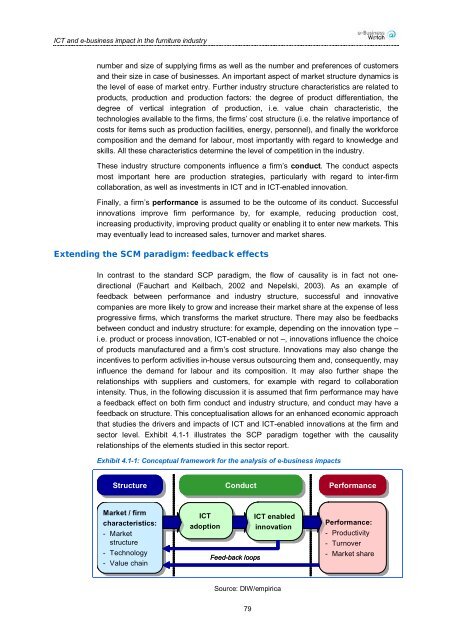ICT and e-Business Impact in the Furniture Industry - empirica
ICT and e-Business Impact in the Furniture Industry - empirica
ICT and e-Business Impact in the Furniture Industry - empirica
- No tags were found...
You also want an ePaper? Increase the reach of your titles
YUMPU automatically turns print PDFs into web optimized ePapers that Google loves.
<strong>ICT</strong> <strong>and</strong> e-bus<strong>in</strong>ess impact <strong>in</strong> <strong>the</strong> furniture <strong>in</strong>dustrynumber <strong>and</strong> size of supply<strong>in</strong>g firms as well as <strong>the</strong> number <strong>and</strong> preferences of customers<strong>and</strong> <strong>the</strong>ir size <strong>in</strong> case of bus<strong>in</strong>esses. An important aspect of market structure dynamics is<strong>the</strong> level of ease of market entry. Fur<strong>the</strong>r <strong>in</strong>dustry structure characteristics are related toproducts, production <strong>and</strong> production factors: <strong>the</strong> degree of product differentiation, <strong>the</strong>degree of vertical <strong>in</strong>tegration of production, i.e. value cha<strong>in</strong> characteristic, <strong>the</strong>technologies available to <strong>the</strong> firms, <strong>the</strong> firms’ cost structure (i.e. <strong>the</strong> relative importance ofcosts for items such as production facilities, energy, personnel), <strong>and</strong> f<strong>in</strong>ally <strong>the</strong> workforcecomposition <strong>and</strong> <strong>the</strong> dem<strong>and</strong> for labour, most importantly with regard to knowledge <strong>and</strong>skills. All <strong>the</strong>se characteristics determ<strong>in</strong>e <strong>the</strong> level of competition <strong>in</strong> <strong>the</strong> <strong>in</strong>dustry.These <strong>in</strong>dustry structure components <strong>in</strong>fluence a firm’s conduct. The conduct aspectsmost important here are production strategies, particularly with regard to <strong>in</strong>ter-firmcollaboration, as well as <strong>in</strong>vestments <strong>in</strong> <strong>ICT</strong> <strong>and</strong> <strong>in</strong> <strong>ICT</strong>-enabled <strong>in</strong>novation.F<strong>in</strong>ally, a firm’s performance is assumed to be <strong>the</strong> outcome of its conduct. Successful<strong>in</strong>novations improve firm performance by, for example, reduc<strong>in</strong>g production cost,<strong>in</strong>creas<strong>in</strong>g productivity, improv<strong>in</strong>g product quality or enabl<strong>in</strong>g it to enter new markets. Thismay eventually lead to <strong>in</strong>creased sales, turnover <strong>and</strong> market shares.Extend<strong>in</strong>g <strong>the</strong> SCM paradigm: feedback effectsIn contrast to <strong>the</strong> st<strong>and</strong>ard SCP paradigm, <strong>the</strong> flow of causality is <strong>in</strong> fact not onedirectional(Fauchart <strong>and</strong> Keilbach, 2002 <strong>and</strong> Nepelski, 2003). As an example offeedback between performance <strong>and</strong> <strong>in</strong>dustry structure, successful <strong>and</strong> <strong>in</strong>novativecompanies are more likely to grow <strong>and</strong> <strong>in</strong>crease <strong>the</strong>ir market share at <strong>the</strong> expense of lessprogressive firms, which transforms <strong>the</strong> market structure. There may also be feedbacksbetween conduct <strong>and</strong> <strong>in</strong>dustry structure: for example, depend<strong>in</strong>g on <strong>the</strong> <strong>in</strong>novation type –i.e. product or process <strong>in</strong>novation, <strong>ICT</strong>-enabled or not –, <strong>in</strong>novations <strong>in</strong>fluence <strong>the</strong> choiceof products manufactured <strong>and</strong> a firm’s cost structure. Innovations may also change <strong>the</strong><strong>in</strong>centives to perform activities <strong>in</strong>-house versus outsourc<strong>in</strong>g <strong>the</strong>m <strong>and</strong>, consequently, may<strong>in</strong>fluence <strong>the</strong> dem<strong>and</strong> for labour <strong>and</strong> its composition. It may also fur<strong>the</strong>r shape <strong>the</strong>relationships with suppliers <strong>and</strong> customers, for example with regard to collaboration<strong>in</strong>tensity. Thus, <strong>in</strong> <strong>the</strong> follow<strong>in</strong>g discussion it is assumed that firm performance may havea feedback effect on both firm conduct <strong>and</strong> <strong>in</strong>dustry structure, <strong>and</strong> conduct may have afeedback on structure. This conceptualisation allows for an enhanced economic approachthat studies <strong>the</strong> drivers <strong>and</strong> impacts of <strong>ICT</strong> <strong>and</strong> <strong>ICT</strong>-enabled <strong>in</strong>novations at <strong>the</strong> firm <strong>and</strong>sector level. Exhibit 4.1-1 illustrates <strong>the</strong> SCP paradigm toge<strong>the</strong>r with <strong>the</strong> causalityrelationships of <strong>the</strong> elements studied <strong>in</strong> this sector report.Exhibit 4.1-1: Conceptual framework for <strong>the</strong> analysis of e-bus<strong>in</strong>ess impactsStructureStructureConductConductPerformanceMarket Market / / firmfirmcharacteristics:characteristics:- - MarketMarketstructurestructure- - TechnologyTechnology- - Value Value cha<strong>in</strong>cha<strong>in</strong><strong>ICT</strong><strong>ICT</strong><strong>ICT</strong> <strong>ICT</strong> enabledenabledadoptionadoption<strong>in</strong>novation<strong>in</strong>novationFeed-back loopsPerformance:Performance:- - ProductivityProductivity- - TurnoverTurnover- - Market Market shareshareSource: DIW/<strong>empirica</strong>79
















